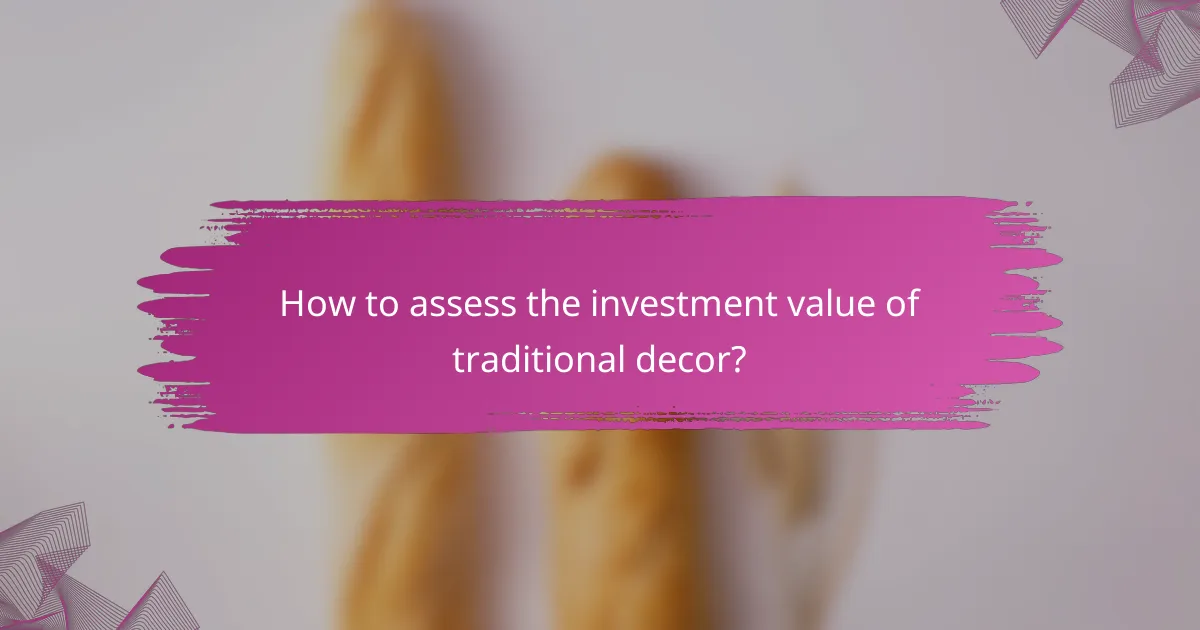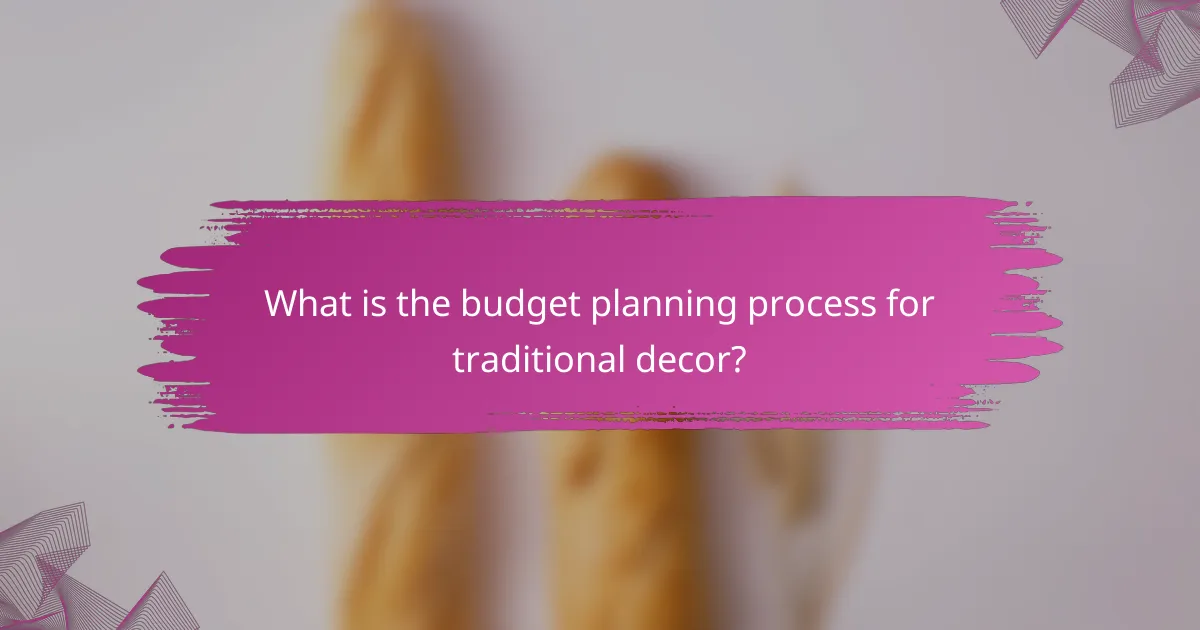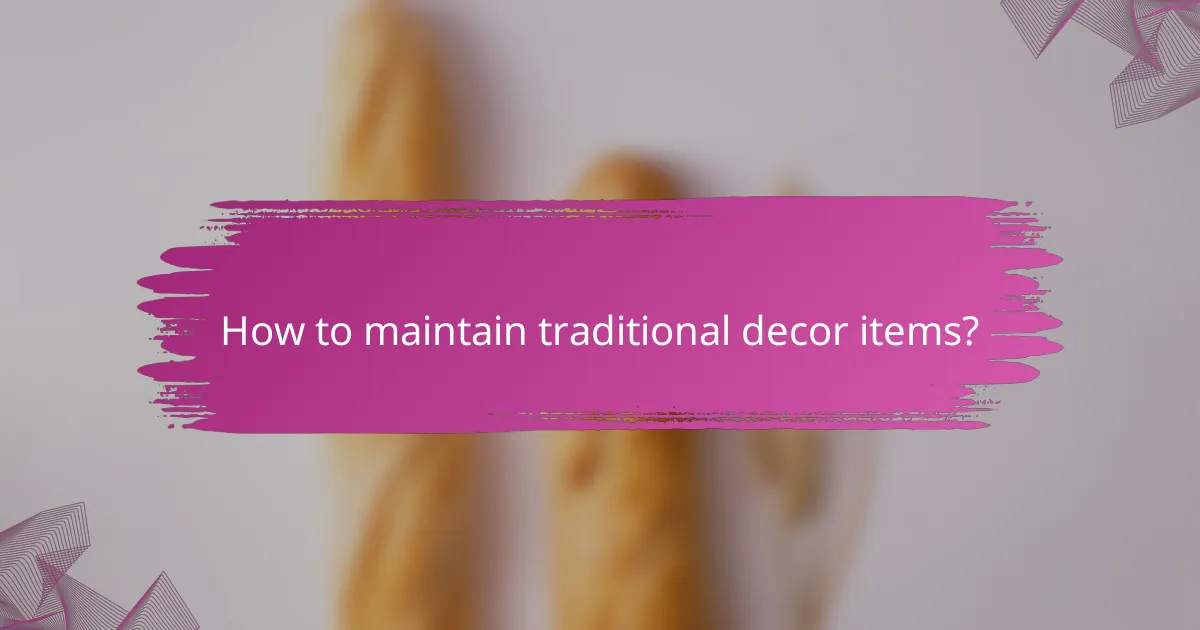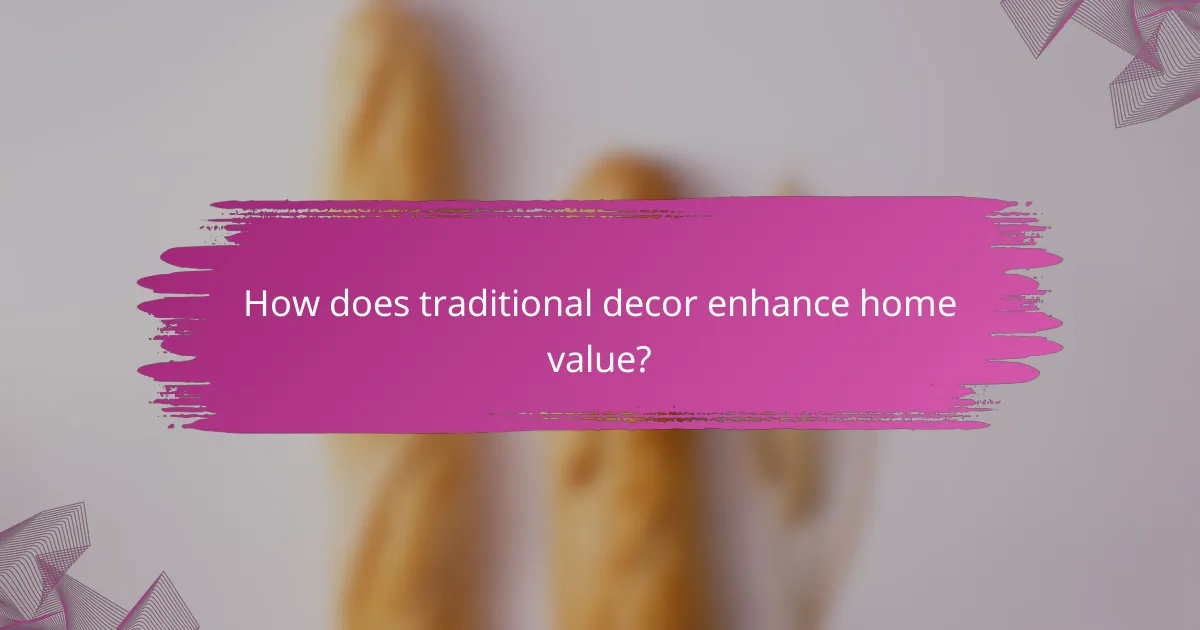Traditional decor offers a unique blend of timeless elegance and potential investment value, making it a popular choice for homeowners. By incorporating classic pieces such as antique furniture and vintage lighting, you can create a sophisticated atmosphere while also considering the long-term appreciation of these items. Effective budget planning is essential to ensure you select key pieces that enhance your space without exceeding your financial limits.

What are the best traditional decor pieces for Canadian homes?
The best traditional decor pieces for Canadian homes include items that reflect classic styles and craftsmanship, enhancing both aesthetic appeal and investment value. Key pieces such as antique furniture, classic rugs, vintage lighting fixtures, traditional artwork, and heritage textiles can create a timeless atmosphere while potentially appreciating in value over time.
Antique furniture
Antique furniture is a cornerstone of traditional decor, offering unique character and history. When selecting pieces, consider their condition, provenance, and style; well-maintained items from recognized periods can significantly increase in value. Look for solid wood constructions and original finishes to ensure longevity and authenticity.
Popular choices include Victorian chairs, Georgian tables, and Arts and Crafts sideboards. These pieces not only serve functional purposes but also act as conversation starters in your home.
Classic rugs
Classic rugs add warmth and texture to traditional spaces, with options ranging from Persian to Oriental styles. When choosing a rug, consider the size and pattern to ensure it complements your existing decor. High-quality wool or silk rugs are often more durable and can retain their value over time.
Investing in a good rug can transform a room, making it feel more inviting. Look for pieces with intricate designs and rich colors that reflect traditional craftsmanship.
Vintage lighting fixtures
Vintage lighting fixtures, such as chandeliers and sconces, can dramatically enhance the ambiance of a traditional home. Opt for fixtures made from materials like brass or wrought iron, which not only provide aesthetic appeal but also durability. Ensure that the lighting complements the scale and style of your space.
Consider incorporating dimmable options to create versatile lighting scenarios. Antique or vintage lighting can often be found at estate sales or specialty shops, making it a worthwhile investment.
Traditional artwork
Traditional artwork, including landscapes, portraits, and still lifes, can add depth and personality to your decor. Look for pieces that resonate with your personal style while also reflecting classic themes. Framing is crucial; ornate frames can enhance the artwork’s impact and tie it into your overall decor.
Investing in original pieces or limited editions can also serve as a financial investment, as art often appreciates over time. Local galleries or antique shops can be great sources for finding unique artworks.
Heritage textiles
Heritage textiles, such as quilts, tapestries, and embroidered pieces, bring warmth and a sense of history to your home. These textiles often feature traditional patterns and craftsmanship that can enrich your decor. When selecting textiles, consider their condition and authenticity, as well as how they will fit into your overall design scheme.
Incorporating these textiles can be as simple as using them as wall hangings or layering them on furniture. They not only enhance visual interest but can also be practical, adding comfort and coziness to your living spaces.

How to assess the investment value of traditional decor?
To assess the investment value of traditional decor, consider factors such as market demand, condition, authenticity, and historical significance. These elements can significantly influence both current worth and future appreciation.
Market demand analysis
Understanding market demand is crucial for evaluating the investment potential of traditional decor. Research current trends in the art and antiques market, focusing on what styles and periods are popular among collectors. Items from well-regarded eras, such as the Victorian or Georgian periods, often see higher demand.
Check auction results and sales data to gauge how similar pieces have performed. High demand can lead to price increases, making it essential to stay informed about shifts in collector interests.
Condition and authenticity
The condition of traditional decor items plays a significant role in their investment value. Pieces that are well-preserved, with minimal wear and tear, typically command higher prices. Look for original finishes and components, as restoration can sometimes diminish value.
Authenticity is equally important; ensure that items are genuine and not reproductions. Provenance, or the history of ownership, can enhance an item’s value, so keep documentation that verifies authenticity when possible.
Historical significance
Items with historical significance often have greater investment potential. Consider the story behind the piece, including its origin, the artist or craftsman, and any notable events associated with it. Pieces linked to significant historical figures or movements can be particularly valuable.
Research the cultural context of the decor item to understand its relevance. Items that reflect important societal changes or artistic movements may appreciate more over time, making them worthwhile investments.

What is the budget planning process for traditional decor?
The budget planning process for traditional decor involves determining how much you can spend, identifying essential pieces, and estimating any restoration costs. This structured approach helps ensure you invest wisely in classic items that enhance your space while staying within financial limits.
Setting a budget range
Establishing a budget range is the first step in planning for traditional decor. Consider your total available funds and decide on a comfortable spending limit, typically between 10% to 20% of your overall home improvement budget. This range allows flexibility while ensuring you don’t overspend.
When setting your budget, factor in both the cost of new pieces and potential expenses for restoration or maintenance. It’s wise to allocate funds for unexpected costs, which can arise during the purchasing or restoration process.
Prioritizing key pieces
Identifying and prioritizing key pieces is crucial in traditional decor. Focus on items that will have the most significant impact on your space, such as antique furniture, classic artwork, or statement lighting. These pieces often serve as focal points and can elevate the overall aesthetic.
Consider creating a list of must-have items versus nice-to-have items. This helps streamline your spending and ensures you acquire essential pieces first, allowing for adjustments later if your budget permits.
Estimating restoration costs
Estimating restoration costs is vital for a realistic budget. Depending on the condition of your traditional decor pieces, restoration can range from minor touch-ups to extensive repairs. For example, refinishing a wooden table might cost between $200 to $600, while reupholstering a vintage chair could range from $300 to $1,000.
Always seek quotes from multiple professionals to get a clear idea of potential costs. Additionally, consider DIY options for minor repairs, which can help save money while allowing you to personalize your decor. Just ensure you have the necessary skills and tools before starting any project.

How to maintain traditional decor items?
Maintaining traditional decor items involves regular cleaning, proper storage, and occasional restoration to preserve their value and appearance. These practices ensure that classic pieces remain in good condition and continue to enhance your living space.
Regular cleaning techniques
Regular cleaning is essential for preserving traditional decor items. Use a soft, lint-free cloth to dust surfaces and avoid harsh chemicals that can damage finishes. For fabrics, a gentle vacuum with a brush attachment can help remove dust without causing wear.
For wooden items, consider using a mixture of mild soap and water for deeper cleaning, followed by a dry cloth to prevent moisture damage. Always test any cleaning solution on a small, inconspicuous area first to ensure it does not harm the material.
Proper storage methods
Proper storage is crucial for protecting traditional decor items when not in use. Store items in a climate-controlled environment to prevent damage from humidity and temperature fluctuations. Use acid-free tissue paper to wrap delicate pieces and avoid stacking items directly on top of each other.
For larger items, consider using padded covers or cases to shield them from dust and scratches. Ensure that storage areas are clean and dry, and check periodically for any signs of pests or deterioration.
Restoration services
If traditional decor items show signs of wear or damage, professional restoration services can help restore their original beauty. Look for specialists who have experience with the specific materials and styles of your pieces, as this expertise is vital for effective restoration.
Restoration can include refinishing wood, reupholstering fabrics, or repairing intricate details. While this service can be an investment, it often significantly enhances the item’s value and longevity, making it worthwhile for cherished pieces.

What are the current trends in traditional decor in Canada?
Current trends in traditional decor in Canada emphasize a blend of classic aesthetics with modern functionality. Homeowners are increasingly seeking pieces that reflect their personal style while maintaining the timeless charm associated with traditional design.
Mixing modern elements
Mixing modern elements with traditional decor is a popular trend that adds freshness to classic styles. This approach can include incorporating contemporary furniture, artwork, or lighting fixtures that contrast with traditional pieces, creating a dynamic visual appeal.
For example, pairing a vintage wooden dining table with sleek, modern chairs can enhance the overall look. This blend not only modernizes the space but also allows for greater versatility in design.
Eco-friendly materials
Eco-friendly materials are becoming essential in traditional decor, reflecting a growing awareness of sustainability. Many homeowners are opting for reclaimed wood, natural fibers, and low-VOC paints to create a healthier living environment.
Using sustainable materials not only supports environmental responsibility but also adds unique character to traditional pieces. For instance, reclaimed wood furniture often features distinctive grain patterns and histories that enhance the decor’s charm.
Personalized decor choices
Personalized decor choices are increasingly important in traditional design, allowing homeowners to express their individuality. Customizing traditional elements, such as upholstery or artwork, can make a space feel more personal and inviting.
Consider incorporating family heirlooms or custom-made pieces that reflect personal stories. This approach not only enriches the decor but also creates a sense of connection and warmth within the home.

How does traditional decor enhance home value?
Traditional decor can significantly enhance home value by creating a timeless aesthetic that appeals to a wide range of buyers. Classic pieces often convey quality craftsmanship and durability, making them attractive investments for homeowners looking to increase their property’s market appeal.
Classic pieces that add value
Classic pieces such as antique furniture, vintage lighting fixtures, and traditional artwork can elevate the overall look of a home. These items not only serve as focal points but also reflect a sense of history and character that modern decor may lack. Investing in high-quality, timeless pieces can yield a return on investment when selling the property.
Investment value of traditional decor
The investment value of traditional decor lies in its ability to retain or even appreciate in worth over time. Unlike trendy items that may quickly go out of style, classic decor tends to maintain its appeal, making it a safer choice for homeowners. For instance, well-preserved antiques can often be sold for significantly more than their purchase price, especially if they are rare or in high demand.
Budget planning for traditional decor
When planning a budget for traditional decor, it’s essential to balance quality with cost. Allocate funds for key pieces that will have the most impact, such as a statement chandelier or a well-crafted dining table. Consider shopping at estate sales, auctions, or reputable antique shops to find quality items at reasonable prices, often ranging from hundreds to thousands of dollars depending on the piece.
